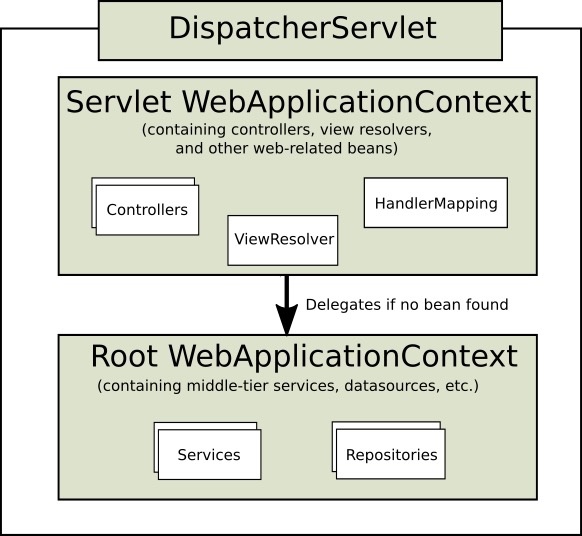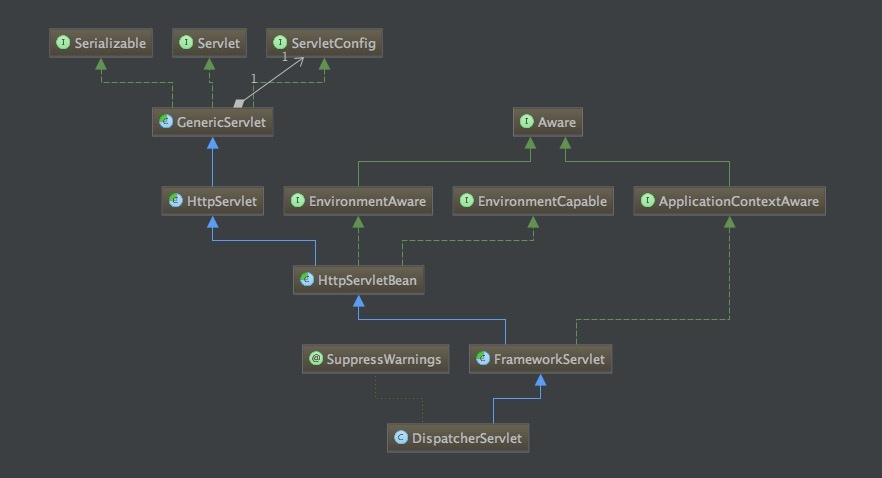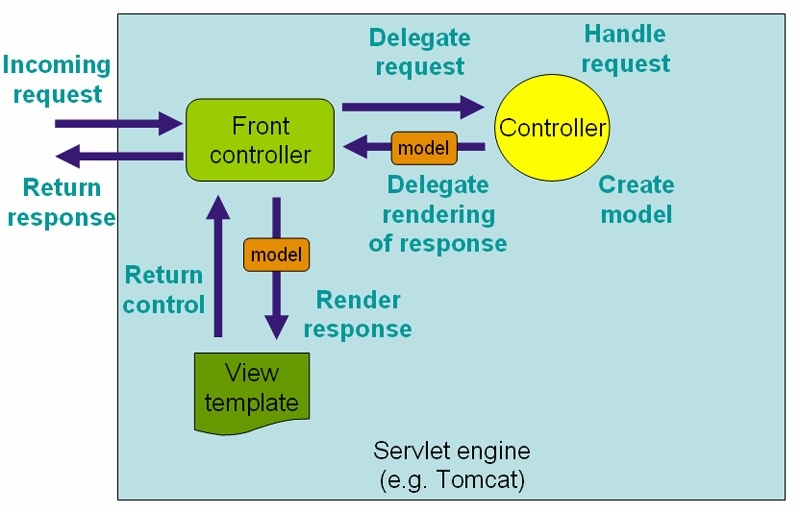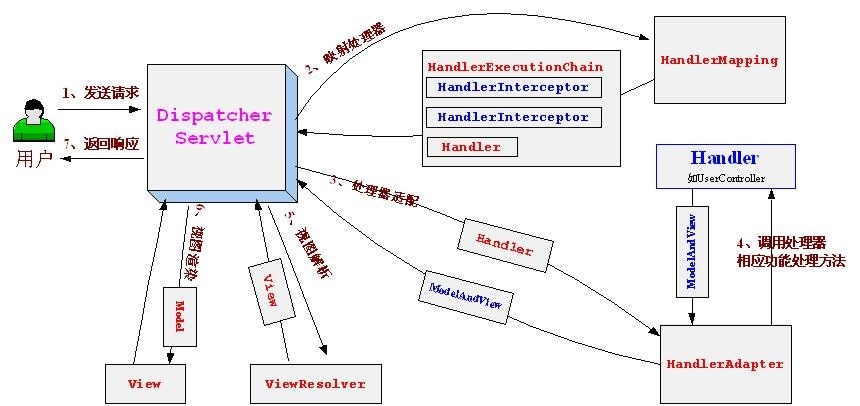SpringMVC源码分析-DispatcherServlet
SpringMVC 框架是 Spring 框架中 web 模块,时下常用来构建 web 应用。在应用之余,也一直想要搞明白 SpringMVC 中是如何接受处理请求的?
SpingMVC 初始化
Spring 框架和其他框架类似,都是配置元素集中于xml配置文件中,在框架初始化的时候,加载配置文件,解析文件,生成对应的配置。 SpringMVC 框架是依托于 Spring 容器。 Spring 初始化的过程其实就是 IoC 容器启动的过程,也就是上下文建立的过程。
ServletContext
每一个web应用中都有一个Servlet上下文。 servlet 容器提供一个全局上下文的环境,这个上下文环境将成为其他 IoC 容器的宿主环境,例如: WebApplicationContext 就是作为 ServletContext 的一个属性存在。
WebApplicationContext
在使用 SpringMVC 的时候,通常需要在 web.xml 文件中配置:
<listener> <listener-class>org.springframework.web.context.ContextLoaderListener</listener-class> </listener>
ContextLoaderListener 实现了 ServletContextListener 接口,在 SpringMVC 中作为监听器的存在,当 servlet 容器启动时候,会调用 contextInitialized 进行一些初始化的工作。而 ContextLoaderListener 中 contextInitialized 的具体实现在 ContextLoader 类中。
try {
// Store context in local instance variable, to guarantee that
// it is available on ServletContext shutdown.
if (this.context == null) {
this.context = createWebApplicationContext(servletContext);
}
if (this.context instanceof ConfigurableWebApplicationContext) {
ConfigurableWebApplicationContext cwac = (ConfigurableWebApplicationContext) this.context;
if (!cwac.isActive()) {
// The context has not yet been refreshed -> provide services such as
// setting the parent context, setting the application context id, etc
if (cwac.getParent() == null) {
// The context instance was injected without an explicit parent ->
// determine parent for root web application context, if any.
ApplicationContext parent = loadParentContext(servletContext);
cwac.setParent(parent);
}
configureAndRefreshWebApplicationContext(cwac, servletContext);
}
}
servletContext.setAttribute(WebApplicationContext.ROOT_WEB_APPLICATION_CONTEXT_ATTRIBUTE, this.context);
上面的部分代码可以看出,初始化时候通过 createWebApplicationContext(servletContext); 声明一个 WebApplicationContext 并赋值给 ServletContext 的 org.springframework.web.context.WebApplicationContext.ROOT 属性,作为 WebApplicationContext 的根上下文(root context)。
DispatcherServlet
在加载完 <context-param> 和 <listener> 之后,容器将加载配置了 load-on-startup 的 servlet 。
<servlet>
<servlet-name>example</servlet-name>
<servlet-class>org.springframework.web.servlet.DispatcherServlet</servlet-class>
<load-on-startup>1</load-on-startup>
</servlet>
<servlet-mapping>
<servlet-name>example</servlet-name>
<url-pattern>/example/*</url-pattern>
</servlet-mapping>
DispatcherServlet 在初始化的过程中,会建立一个自己的 IoC 容器上下文 Servlet WebApplicationContext ,会以 ContextLoaderListener 建立的根上下文作为自己的父级上下文。 DispatcherServlet 持有的上下文默认的实现类是 XmlWebApplicationContext 。 Servlet 有自己独有的 Bean 空间,也可以共享父级上下文的共享 Bean ,当然也存在配置有含有一个 root WebApplicationContext 配置。其关系如下图所示,后面也还会详细介绍 DispatcherServlet 这个类。

DispatcherServlet类
DispatcherServlet 最为SpringMVC核心类,起到了前端控制器(Front controller)的作用,负责请求分发等工作。

从类图中可以看出, DispatcherServlet 的继承关系大致如此:
DispatcherServlet -> FrameworkServlet -> HttpServletBean -> HttpServlet -> GenericServlet
从继承关系上可以得出结论, DispatcherServlet 本质上还是一个 Servlet 。 Servlet 的生命周期大致分为三个阶段:
- 初始化阶段 init方法
- 处理请求阶段 service方法
- 结束阶段 destroy方法
这里就重点关注 DispatcherServlet 在这三个阶段具体做了那些工作。
DispatcherServlet初始化
DispatcherServlet 的 init() 的实现在其父类 HttpServletBean 中。
public final void init()throwsServletException{
...
// Set bean properties from init parameters.
try {
PropertyValues pvs = new ServletConfigPropertyValues(getServletConfig(), this.requiredProperties);
BeanWrapper bw = PropertyAccessorFactory.forBeanPropertyAccess(this);
ResourceLoader resourceLoader = new ServletContextResourceLoader(getServletContext());
bw.registerCustomEditor(Resource.class, new ResourceEditor(resourceLoader, getEnvironment()));
initBeanWrapper(bw);
bw.setPropertyValues(pvs, true);
}
catch (BeansException ex) {
logger.error("Failed to set bean properties on servlet '" + getServletName() + "'", ex);
throw ex;
}
// Let subclasses do whatever initialization they like.
initServletBean();
...
}
以上部分源码描述的过程是通过读取 <init-param> 的配置元素,读取到 DispatcherServlet 中,配置相关 bean 的配置。完成配置后调用 initServletBean 方法来创建 Servlet WebApplicationContext 。
initServletBean 方法在 FrameworkServlet 类中重写了:
protected final void initServletBean()throwsServletException{
...
try {
this.webApplicationContext = initWebApplicationContext();
initFrameworkServlet();
}
...
}
protectedWebApplicationContextinitWebApplicationContext(){
WebApplicationContext rootContext =
WebApplicationContextUtils.getWebApplicationContext(getServletContext());
WebApplicationContext wac = null;
if (this.webApplicationContext != null) {
wac = this.webApplicationContext;
if (wac instanceof ConfigurableWebApplicationContext) {
ConfigurableWebApplicationContext cwac = (ConfigurableWebApplicationContext) wac;
if (!cwac.isActive()) {
if (cwac.getParent() == null) {
cwac.setParent(rootContext);
}
configureAndRefreshWebApplicationContext(cwac);
}
}
}
if (wac == null) {
wac = findWebApplicationContext();
}
if (wac == null) {
wac = createWebApplicationContext(rootContext);
}
if (!this.refreshEventReceived) {
onRefresh(wac);
}
if (this.publishContext) {
String attrName = getServletContextAttributeName();
getServletContext().setAttribute(attrName, wac);
if (this.logger.isDebugEnabled()) {
this.logger.debug("Published WebApplicationContext of servlet '" + getServletName() +
"' as ServletContext attribute with name [" + attrName + "]");
}
}
return wac;
}
上文提到 Servlet 容器在启动的时候,通过 ContextLoaderListener 创建一个根上下文,并配置到 ServletContext 中。可以看出 FrameworkServlet 这个类做的作用是用来创建 WebApplicationContext 上下文的。大致过程如下:
- 首先检查
webApplicationContext是否通过构造函数注入,如果有的话,直接使用,并将根上下文设置为父上下文。 - 如果
webApplicationContext没有注入,则检查是否在ServletContext已经注册过,如果已经注册过,直接返回使用。 - 如果没有注册过,将重新新建一个
webApplicationContext。将根上下文设置为父级上下文。 - 不管是何种策略获取的
webApplicationContext,都将会调用onRefresh方法,onRefresh方法会调用initStrategies方法,通过上下文初始化HandlerMappings、HandlerAdapters、ViewResolvers等等。 - 最后,同样会将所得
webApplicationContext注册到ServletContext中。
而 initFrameworkServlet() 默认的实现是空的。这也可算是 SpingMVC 留的一个扩展点。
DispatcherServlet处理请求
纵观 SpringMVC 的源码,大量运用模板方法的设计模式。 Servlet 的 service 方法也不例外。 FrameworkServlet 类重写 service 方法:
@Override
protected void service(HttpServletRequest request, HttpServletResponse response)
throws ServletException, IOException {
HttpMethod httpMethod = HttpMethod.resolve(request.getMethod());
if (HttpMethod.PATCH == httpMethod || httpMethod == null) {
processRequest(request, response);
}
else {
super.service(request, response);
}
}
如果请求的方法是 PATCH 或者空,直接调用 processRequest 方法(后面会详细解释);否则,将调用父类的 service 的方法,即 HttpServlet 的 service 方法, 而这里会根据请求方法,去调用相应的 doGet 、 doPost 、 doPut ……
而 doXXX 系列方法的实现并不是 HttpServlet 类中,而是在 FrameworkServlet 类中。在 FrameworkServlet 中 doXXX 系列实现中,都调用了上面提到的 processRequest 方法:
protected final void processRequest(HttpServletRequest request, HttpServletResponse response)
throws ServletException, IOException {
long startTime = System.currentTimeMillis();
Throwable failureCause = null;
LocaleContext previousLocaleContext = LocaleContextHolder.getLocaleContext();
LocaleContext localeContext = buildLocaleContext(request);
RequestAttributes previousAttributes = RequestContextHolder.getRequestAttributes();
ServletRequestAttributes requestAttributes = buildRequestAttributes(request, response, previousAttributes);
WebAsyncManager asyncManager = WebAsyncUtils.getAsyncManager(request);
asyncManager.registerCallableInterceptor(FrameworkServlet.class.getName(), new RequestBindingInterceptor());
initContextHolders(request, localeContext, requestAttributes);
try {
doService(request, response);
}
catch (ServletException ex) {
failureCause = ex;
throw ex;
}
catch (IOException ex) {
failureCause = ex;
throw ex;
}
catch (Throwable ex) {
failureCause = ex;
throw new NestedServletException("Request processing failed", ex);
}
finally {
resetContextHolders(request, previousLocaleContext, previousAttributes);
if (requestAttributes != null) {
requestAttributes.requestCompleted();
}
if (logger.isDebugEnabled()) {
if (failureCause != null) {
this.logger.debug("Could not complete request", failureCause);
}
else {
if (asyncManager.isConcurrentHandlingStarted()) {
logger.debug("Leaving response open for concurrent processing");
}
else {
this.logger.debug("Successfully completed request");
}
}
}
publishRequestHandledEvent(request, response, startTime, failureCause);
}
}
为了避免子类重写它,该方法用 final 修饰。
- 首先调用
initContextHolders方法,将获取到的localeContext、requestAttributes、request绑定到线程上。 - 然后调用
doService方法,doService具体是由DispatcherServlet类实现的。 -
doService执行完成后,调用resetContextHolders,解除localeContext等信息与线程的绑定。 - 最终调用
publishRequestHandledEvent发布一个处理完成的事件。
DispatcherServlet 类中的 doService 方法实现会调用 doDispatch 方法,这里请求分发处理的主要执行逻辑。
protected void doDispatch(HttpServletRequest request, HttpServletResponse response)throwsException{
HttpServletRequest processedRequest = request;
HandlerExecutionChain mappedHandler = null;
boolean multipartRequestParsed = false;
WebAsyncManager asyncManager = WebAsyncUtils.getAsyncManager(request);
try {
ModelAndView mv = null;
Exception dispatchException = null;
try {
processedRequest = checkMultipart(request);
multipartRequestParsed = (processedRequest != request);
// Determine handler for the current request.
mappedHandler = getHandler(processedRequest);
if (mappedHandler == null || mappedHandler.getHandler() == null) {
noHandlerFound(processedRequest, response);
return;
}
// Determine handler adapter for the current request.
HandlerAdapter ha = getHandlerAdapter(mappedHandler.getHandler());
// Process last-modified header, if supported by the handler.
String method = request.getMethod();
boolean isGet = "GET".equals(method);
if (isGet || "HEAD".equals(method)) {
long lastModified = ha.getLastModified(request, mappedHandler.getHandler());
if (logger.isDebugEnabled()) {
logger.debug("Last-Modified value for [" + getRequestUri(request) + "] is: " + lastModified);
}
if (new ServletWebRequest(request, response).checkNotModified(lastModified) && isGet) {
return;
}
}
if (!mappedHandler.applyPreHandle(processedRequest, response)) {
return;
}
// Actually invoke the handler.
mv = ha.handle(processedRequest, response, mappedHandler.getHandler());
if (asyncManager.isConcurrentHandlingStarted()) {
return;
}
applyDefaultViewName(processedRequest, mv);
mappedHandler.applyPostHandle(processedRequest, response, mv);
}
catch (Exception ex) {
dispatchException = ex;
}
catch (Throwable err) {
// As of 4.3, we're processing Errors thrown from handler methods as well,
// making them available for @ExceptionHandler methods and other scenarios.
dispatchException = new NestedServletException("Handler dispatch failed", err);
}
processDispatchResult(processedRequest, response, mappedHandler, mv, dispatchException);
}
catch (Exception ex) {
triggerAfterCompletion(processedRequest, response, mappedHandler, ex);
}
catch (Throwable err) {
triggerAfterCompletion(processedRequest, response, mappedHandler,
new NestedServletException("Handler processing failed", err));
}
finally {
if (asyncManager.isConcurrentHandlingStarted()) {
// Instead of postHandle and afterCompletion
if (mappedHandler != null) {
mappedHandler.applyAfterConcurrentHandlingStarted(processedRequest, response);
}
}
else {
// Clean up any resources used by a multipart request.
if (multipartRequestParsed) {
cleanupMultipart(processedRequest);
}
}
}
}
doDispatch 主要流程是:
- 先判断是否
Multipart类型的请求。如果是则通过multipartResolver解析request - 通过
getHandler方法找到从HandlerMapping找到该请求对应的handler,如果没有找到对应的handler则抛出异常。 - 通过
getHandlerAdapter方法找到handler对应的HandlerAdapter - 如果有拦截器,执行拦截器
preHandler方法 -
HandlerAdapter执行handle方法处理请求,返回ModelAndView。 - 如果有拦截器,执行拦截器
postHandle方法 - 然后调用
processDispatchResult方法处理请求结果,封装到response中。
SpingMVC 请求处理流程
SpringMVC 框架是围绕 DispatcherServlet 设计的。 DispatcherServlet 负责将请求分发给对应的处理程序。从网上找了两个图,可以大致了解 SpringMVC 的框架对请求的处理流程。


- 用户发送请求,
Front Controller(DispatcherServlet)根据请求信息将请求委托给对应的Controller进行处理。 -
DispatcherServlet接收到请求后,HandlerMapping将会把请求封装为HandlerExecutionChain,而HandlerExecutionChain包含请求的所有信息,包括拦截器、Handler处理器等。 -
DispatcherServlet会找到对应的HandlerAdapter,并调用对应的处理方法,并返回一个ModelAndView对象。 -
DispatcherServlet会将ModelAndView对象传入View层进行渲染。 - 最终
DispatcherServlet将渲染好的response返回给用户。
总结
本文主要分析 SpringMVC 中 DispatcherServlet 的初始化、请求流传过程等。
发现了 SpringMVC 中在 DispatcherServlet 的实现过程中运用了模板方法设计模式,看到 SpringMVC 中留给用户可扩展的点也有很多,体会到 Open for extension, closed for modification 的设计原则。
本文只关注了 DispatcherServlet 主流程,忽略了很多宝贵的细枝末节,如: HandlerMapping 、 HandlerExecutionChain 、 HandlerAdapter 等。后面有机会定会追本溯源。











![[HBLOG]公众号](https://www.liuhaihua.cn/img/qrcode_gzh.jpg)

